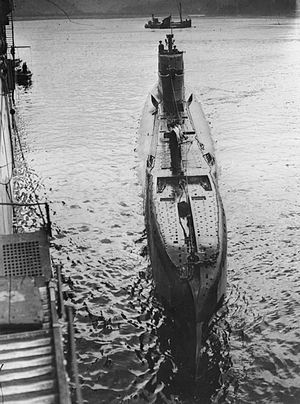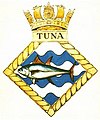HMS Tuna (N94)

HMS Tuna approaching the submarine depot ship HMS Forth in Holy Loch (Scotland) in August 1943
|
|
| History | |
|---|---|
|
|
|
| Name: | HMS Tuna |
| Ordered: | 9 December 1937 |
| Builder: | Scotts, Greenock |
| Laid down: | 13 June 1938 |
| Launched: | 10 May 1940 |
| Commissioned: | 1 August 1940 |
| Honours and awards: |
|
| Fate: | Broken up in June 1946 |
| Badge: | |
| General characteristics | |
| Class and type: | British T class submarine |
| Displacement: |
|
| Length: | 275 ft (84 m) |
| Beam: | 26 ft 6 in (8.08 m) |
| Draught: | 16.3 ft (5.0 m) |
| Propulsion: |
|
| Speed: |
|
| Range: | 4,500 nautical miles at 11 knots (8,330 km at 20 km/h) surfaced |
| Test depth: | 300 ft (91 m) max |
| Complement: | 59 |
| Armament: |
|
HMS Tuna (N94) was a T-class submarine of the Royal Navy. She was laid down by Scotts, Greenock (in Scotland) and launched on 10 May 1940. She was equipped with German-built engines and spent her career in World War II in western European waters, in the North Sea and off the west coast of France, most famously taking part in Operation Frankton, the raid on Bordeaux later immortalised in the film The Cockleshell Heroes. She also took part in many war patrols and her crew received service medals for the boat's destruction of several U-boats.
Tuna was ordered from Scotts Shipbuilding and Engineering Company on 9 December 1937, as part of an extension of the 1937 construction programme, with an initial four submarines ordered earlier that year in July. Tuna was part of a further three boats to be ordered, along with Triad and Truant, which were obtained from another shipbuilder.
She was equipped with diesel engines produced by MAN SE, a German company. The engines had been delivered before the war, and spare parts were rare, members of the crew at least once creating replacement parts from other equipment while at sea.
Tuna had a relatively active career, serving in the North Sea and off the French and Scandinavian coasts.
She sank the 7,230-ton merchantman Tirranna on 22 September 1940. The Tirranna was a Norwegian ship that had been captured by the German armed merchant cruiser Atlantis, in the Indian Ocean. Tirranna had 292 on board when she was sunk, including at least 264 captured Allied sailors and a 16-strong German prize crew. Eighty-seven people died in the sinking, including one German. She also torpedoed and sank the German catapult ship Ostmark and the French tug Chassiron. She fired upon and sank the German submarine U-644 and attacked the German submarine U-302 and the Italian submarine Brin as well as two unidentified submarine contacts, all unsuccessfully. An attack also failed on the German tanker Benno, formerly the Norwegian Ole Jacob, which had also been captured earlier by the Atlantis.
...
Wikipedia

